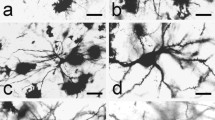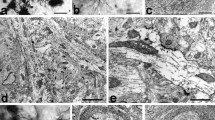Summary
Neuronal types of the human clastrum have been investigated by means of a transparent Golgi technique which enables one to study the characteristics of not only the cellular processes but also the marking features of the nuclei, the cellular organelles, and the paraplasmic substances of various types of nerve cells.
Five varieties of neurons have been distinguished:
Type I represents a class of spiny nerve cells varying to a certain extent in size and shape. These cells contain fine and widely dispersed lipofuscin granules which can only faintly be tinged by aldehydefuchsin.
Type II cells are large aspiny neurons. Their cell bodies contain a great number of deeply stained coarse pigment granules.
Type III cells are large aspiny neurons devoid of pigment deposits.
Type IV is a small pigment-laden aspiny neuron.
Type V is a small aspiny neuron devoid of lipofuscin granules.
The pattern of pigmentation revealed by the different types of nerve cells turns out to be highly characteristic. It can well be used for classification of the various types of nerve cells which occur within the reaches of the claustrum.
Similar content being viewed by others
References
Astruc J (1971) Corticofugal connections of area 8 (frontal eye field) in Macaca mulatta. Brain Res 33:241–256
Berke JJ (1960) the claustrum, the external capsule and the extreme capsule of Macaca mulatta. J. Comp. Neurol. 115:297–331
Braak H (1978) On the pigmentarchitectonics of the human telencephalic cortex. In: MAB Brazier, H Petsche (eds) Architectonics of the cerebral cortex. Raven Press, New York
Braak H (1980) Architectonics of the human telencephalic cortex. Springer, Berlin Heidelberg New York
Braak H (in prep.) Transparent Golgi-impregnations: a way to examine both details of the cellular processes and components of the cell body
Braak H, Braak E (1981) Korrelation zwischen dem Fortsatzbild eines Neurons und seinen cytoplasmatischen Bestandteilen mit Hilfe einer transparenten Golgi-Imprägnation. Jahrestagung dtsch. Neurobiol. Göttingen
Braak H, Goebel HH (1978) Loss of pigment-laden stellate cells: a severe alteration of the isocortex in juvenile neuronal ceroid-lipofuscinosis. Acta Neuropathol (Berl.) 42:53–57
Braitenberg V, Guglielmotti U, Sada E (1967) Correlation of cyrstal growth with the staining of axons by the Golgi procedure. Stain Technol 42:277–283
Brand S (1981) A serial section Golgi analysis of the primate claustrum. Anat Embryol 162:475–488
Brockhaus H (1940) Die Cyto- und Myeloarchitektonik des Cortex claustralis und des Claustrum beim Menschen. J Psychol Neurol 49:249–348
Carey RG, Fitzpatrick D, Diamond IT (1979) Layer I of striate cortex of Tupaia glis and Galago senegalensis: projections from thalamus and claustrum revealed by retrograde transport of horseradish peroxidase. J Comp Neurol 186:393–438
Carey RG, Bear MF, Diamond IT (1980) The laminar organization of the reciprocal projections between the claustrum and striate cortex in the tree shrew, Tupaia glis. Brain Res 184:193–198
Carman JB, Cowan WM, Powell TPS (1964) The cortical projection upon the claustrum. J Neurol Neurosurg Psychiat 27:46–51
Chadzypanagiotis D, Narkiewicz O (1971) Connections of the visual cortex with the claustrum. Acta Neurobiol (Warsaw) 31:291–311
Colonnier M (1968) Synaptic patterns of different cell types in the different laminae of the cat visual cortex. An electron microscope study. Bran Res 9:269–287
DeVito JL, Smith OA (1964) Subcortical projections of the prefrontal lobe of the monkey. J Comp Neurol 123:413–424
Druga R (1966a) The claustrum of the cat (Felis domestica). Folia Morphol (Praha) 14:7–16
Druga R (1966b) Cortico-claustral connections. I. Fronto-claustral connections. Folia Morphol (Praha) 14:391–399
Druga R (1968) Cortico-claustral connections. II. Connections from the parietal, temporal and occipital cortex to the claustrum. Folia Morphol (Praha) 16:142–149
Druga R (1971) Projection of prepyriform cortex into claustrum. Folia Morphol (Praha) 19:405–410
Druga R (1972) Efferent projections from the claustrum (an experimental study using Nauta's method). Folia Morphol (Praha) 20:163–165
Druga R (1974) The claustrum and the transitional neo-palaeo-cortical area of the hedgehog (Erinaceus europaeus). Anat Anz 135:442–454
Filimonoff IN (1966) The claustrum, its origin and development. J Hirnforsch 8:503–528
Irvine DRF, Brugge JF (1980) Afferent and efferent connections between the claustrum and parietal association cortex in cat: a horseradish peroxidase and autoradiographic study. Neurosci Lett 20:5–10
Javaraman A, Updyke BV (1979) Organization of visual cortical projections to the claustrum in the cat. Brain Res 178:107–115
Juraniec J, Narkiewicz O, Wrzolkowa T (1971) Axon terminals in the claustrum of the cat: an electron microscopic study. Brain Res 35:277–282
Künzle H, Akert K (1977) Efferent connections of cortical area 8 (frontal eye field) in Macaca fascicularis. A reinvestigation using the autoradiographic technique. J Comp Neurol 173:147–164
Leichnetz GR, Astruc J (1975) Efferent connections of the orbitofrontal cortex in the marmoset (Saguinus oedipus). Brain Res 84:169–180
Macchi G, Bentivoglio M, Minciacchi D, Molinari M (1981) The organization of the claustroneocortical projections in the cat studied by means of the HRP retrograde axonal transport. J Comp Neurol 195:681–695
Miodonski R (1975) The claustrum in the dog brain. Acta anat 91:409–422
Narkiewicz O (1964) Degenerations in the claustrum after regional neocortical ablations in the cat. J Comp Neurol 123:335–356
Norita M, Hirata Y (1976) Some electron microscope findings of the claustrum of the cat. Arch Histol Jpn 39:33–49
Olson CR, Graybiel AM (1980) Sensory maps in the claustrum of the cat. Nature 288:479–481
Pasik P, Pasik T, Difiglia M (1979) The internal organization of the neostriatum in mammals. In I Divac, GE Oberg (eds) The neostriatum. Pergamon Press, Oxford New York
Rae ASL (1954) The form and structure of the human claustrum. J Comp Neurol 100:15–40
Riche D, Lanoir J (1978) Some claustro-cortical connections in the cat and baboon as studied by retrograde horseradish peroxidase transport. J Comp Neurol 177:435–444
Squatritio S, Battaglini PP, Galletti C, Riva Sanseverino E (1980) Autoradiographic evidence for projections from cortical visual areas 17, 18, 19 and the Clare-Bishop area to the ipsilateral claustrum in the cat. Neurosci Lett 19:265–270
Author information
Authors and Affiliations
Rights and permissions
About this article
Cite this article
Braak, H., Braak, E. Neuronal types in the claustrum of man. Anat Embryol 163, 447–460 (1982). https://doi.org/10.1007/BF00305558
Accepted:
Issue Date:
DOI: https://doi.org/10.1007/BF00305558




